
What is a Demand for Preservation of Evidence Letter? Examples & e-Discovery

What is a Demand for Preservation of Evidence Letter? Examples & e-Discovery
A demand for preservation of evidence letters mailed to future personal injury defendants remains an underused tool in the unique injury profession. However, it is vital for many reasons, which we will discuss below. Moreover, it tells people you are going to file a claim for personal injury or death. The defendant is now said to be on notice.
These are particularly helpful in landlord-tenant cases and employment law cases. It will be hard for them to lose evidence and later say they had no duty to preserve it independently. You must demand that the potential defendants protect all documents and other things, such as hard drives, electronic images or videos, etc. But the more specific you are, the better. So, you will specify in the letter that the future defendant must maintain papers such as timesheets, pictures, cell phones, dispatch records, etc.
Later, in discovery, the personal injury plaintiff will demand these items, along with the custodian’s names, addresses, and contact information of any evidence. At the trial or during settlement negotiations, if this evidence would have been helpful to the plaintiff but had been withheld, any new evidence later used by the defendant to vindicate their liability shall be viewed with distrust.
The determination of fault in civil tort claims is of the utmost importance to a severely wounded victim. However, proving a personal injury case is the plaintiff’s burden. During the period before the lawsuit is filed, the defendant may try and hide or destroy evidence. If they didn’t know they were being sued, it might have just been an innocent part of regular housekeeping for some businesses and others. However, plaintiffs can use this vital tool to place people on notice to keep them from destroying or misplacing evidence. Let’s use this example to help people understand.
For example, if the plaintiff intends to sue ARCO for a slip and fall accident at their gas station due to poor lighting, there may be a videotape. But typically, after three days, that evidence gets destroyed. How do you get that evidence? Of course, in other cases, the person with custody of the evidence may not even be a potential defendant. Go ahead and notice them anyway.
There are many reasons for notifying non-parties to preserve evidence. Most of all, it remains essential to determine who is at fault for the accident and to put them on notice. Sometimes, in a hit-and-run case, for example, you may only have the numbers of the defendant driver’s vehicle license plates and have no way to run them through the DMV computer. By the time the police track the vehicle down, the perpetrator may have already made repairs. If so, where is the repair shop’s evidence of repairs, and were photos taken?
It is essential to let people know they have your evidence and may have legal proof in a criminal and civil case. Even if these witnesses are not good Samaritans, they are on notice that they may have a legal duty in a pending case! It also tells them they may be called as witnesses. Moreover, it remains a powerful tool in displaying to defendants that you have a solid case.
So, the next logical step is to write a letter to all potential witnesses and defendants documenting the accident’s basic facts (party names, dates, times, and location) and your injuries. But how do I notify a personal injury defendant when I have no lawyer? The plaintiff has two options: hire a lawyer or use a guide like the one below and “do it yourself.”
Powerful, Withheld Evidence, “Shall Viewed With Distrust”?
Yes, this is correct. After properly demanding the preservation of documents and other things, the plaintiff can seek jury instruction regarding destroyed or lost evidence that occurs after the defendant receives the plaintiff’s preservation letter.
“If weaker and less satisfactory evidence is offered when it was within the power of the party to produce stronger and more satisfactory evidence, the evidence offered should be viewed with distrust.” (Source).
As noted above, the “shall” be viewed with distrust provision, which would not apply if the evidence had been turned over. This Evidence Code section seeks to deny a party the right to benefit from their own secretive, evil deeds. In some cases, the court “In Limine” may order the exculpatory or more satisfactory evidence to the plaintiff’s case thrown out!
If the defendant destroys vital evidence, what they produce will be distrusted. However, the defendant may seek to parlay and offer more favorable settlement terms. As can be seen, Evidence Code Section 412 is a powerful tool for either party, as a sword or. You will also notify the driver’s company and your insurance company, if possible. But not all cases remain cut and dry. For example, workplace injuries will have different lines of determining who may be at fault. And some are relatively straightforward. But others need the expertise of a skilled attorney.
Why Make Sure And Keep Copies?
When you have figured out who you believe to be at fault, you must craft the letter to send them. Make sure that you keep copies of the letter for your records. If possible, get it notarized and send it by certified mail; a return receipt is requested. And send a second copy via regular U.S. First Class Mail. By submitting such a notification, the parties will be on notice under the mailbox rule. Your message will “state the facts” and not blame any party for the incident. Your evidence or their admission will do that for you. Sending the letter registered, or certified mail, with the return receipt requested is a good idea, even though the “Mailbox Rule” applies.
In the crucial hours and days after an accident, it is essential not to dawdle. Don’t miss any statutes of limitations of insurance filing deadlines. Send out the preservation of evidence letters within several weeks of the accident. As can be seen, a demand to preserve evidence can be a powerful tool for personal injury plaintiffs. Parties must send requests to anyone with evidence, not just potential parties to the lawsuit. Plaintiffs are encouraged not to do it themselves.
However, sometimes, they have no choice due to timing or other reasons. While the plaintiff may not file a complaint in court right away, later on, an attorney can help the plaintiff understand their legal rights in these cases. Preserving the evidence letter will be an excellent way for the new lawyer to seek motions limiting the defendant’s evidence, which could effectuate a more favorable settlement.
E-Discovery Duty to Preserve
There is a duty to preserve electronically stored information (ESI) in many California court cases. ESI includes data, documents, and materials. Even if it is not admissible directly, it could lead to other admissible evidence. You must not destroy electronically stored information or alter or conceal it. Anything is potentially relevant evidence. So, it will likely be a part of litigation. This rule means that counsel must act reasonably in the preservation of ESI. The duty extends to many classes of people. These classes include the client, parents, attorneys, partners, employees, officers, directors, divisions, subdivisions, contractors, accountants, auditors, and subsidiaries.
Preservation Of Evidence Letter
It is critical to send a “preservation of evidence” letter at the outset to all interested parties in PI cases. However, a legal hold is essential for both the plaintiff’s and the defendant’s counsel. The plaintiff’s attorney should send a letter to potential clients or their lawyers. This will be a notice of the filing of a lawsuit. Getting a preservation order from the court is often the smart move.
Also, please don’t leave the preservation of evidence up to the client or their IT department. Metadata remains easily alterable, and copying files onto paper is another way to alter these electronic documents. Variations in the electronically stored information can prove the authenticity or integrity of the stored data. Failure to preserve ESI has resulted in sanctions, such as spoliation penalties and “doomsday sanctions.”
If electronically stored data is not protected, it can be devastating to the client. A careless, intentional, or reckless deletion does not count. The attorney failing to ensure the preservation order or litigation hold can be in trouble. Also, the State Bar Association could disbar or suspend the lawyer.
What Does the Law Require?
The law requires each party to preserve all potentially discoverable electronically saved information. These laws impose duties that apply to each party and any third party.
- ESI cannot be altered or deleted once it is notified. File fragments or remnants of any changed or deleted information remain discoverable.
- Parties must invoke procedures to protect electronically stored information, including related metadata, from data compression, deletion, overwriting, or rotation.
- Parties must protect ESI from tampering, such as disk defragmentation, reformatting, and other optimization routines.
- Do not dispose of data storage devices. Media often gets replaced during upgrading, so keep that in mind.
- All application programs and utility program copies must be preserved. Anything used in accessing, processing, reading, copying, or displaying remains discoverable.
Also, professionals can make forensic copies of any potential electronically stored evidence. So that way, you can avoid confiscating USB drives, iPods, laptops, or other equipment. So both sides can continue the business. Most importantly, maintain a proper chain of custody record for the ESI.
This custody applies in particular to loose and removable items like Blackberrys. Maintaining logs remains vital. Then, it may be possible to show the judge that the lateness was due to an innocent error. At least that way, it wasn’t intentional.
ESI and Metadata
Metadata can be critical, which is data about other data. This data was not an issue with paper documents since the data would have been recorded, such as the date and author. Electronically stored information has changed discovery rules. For example, metadata and online searches for porn can embarrass you.
Metadata issues can include:
- Tracking is potentially damaging changes to documents.
- Modifications of document creation dates, accessed, the number of revisions, and the total amount of time for editing remain discoverable.
- Your ability to follow the internet email route by viewing the entire header remains vital.
- This process can identify those unthinkingly copied on an email (BCC).
- Knowledge of comments and secret formulas in spreadsheets.
What About the Digital Fingerprint?
Metadata has a digital fingerprint that can change any part of a document, including other metadata. The most significant benefit of metadata is the advantage of more effective searches. Some metadata remains accessible in “properties” in MS Word Documents. Also, some emails in the “to” and “from” fields are available. Once learned, these rules can help you win.
You have to turn over everything on your hard drive without an agreement. The problem is that unless you request the metadata, only paper documents can be received. So you must ask for the data in electronic form. If not, you will be digging through piles of paper. The defendant must include the metadata to specify that the file format is a raw native.
Most of all, the preservation of evidence letter sends a powerful shot across the other party’s bow. It lets them know that you know your rights. To learn more about your rights, contact Ehline Law Firm Personal Injury Attorneys, APLC, at (213) 596-9642. If you want to learn more about demands to preserve evidence or need a template, please contact us using our online Contact Us form.
Categories
- A to Z Personal Injury Podcast
- Car Accident
- Government Tort Blog
- Insurance Law Blog
- Piloting and Aviation Accident Blog
- Premises Liability Blog
- Products Defect Blog
- Recreation-Sports Accident Blog
- Reports
- Service Related Cancer Blog
- Sexual Assault Blog
- Spinal Cord Injury Blog
- Torts, Examples, Explanations
- Train Accidents Blog
- TV, Media & Firm News
- Uncategorized
Firm Archive
Main Los Angeles Location

Michael Ehline
Michael Ehline is an inactive U.S. Marine and world-famous legal historian. Michael helped draft the Cruise Ship Safety Act and has won some of U.S. history’s largest motorcycle accident settlements. Together with his legal team, Michael and the Ehline Law Firm collect damages on behalf of clients. We pride ourselves on being available to answer your most pressing and difficult questions 24/7. We are proud sponsors of the Paul Ehline Memorial Motorcycle Ride and a Service Disabled Veteran Operated Business. (SDVOB.) We are ready to fight.
Go here for More Verdicts and Settlements.

